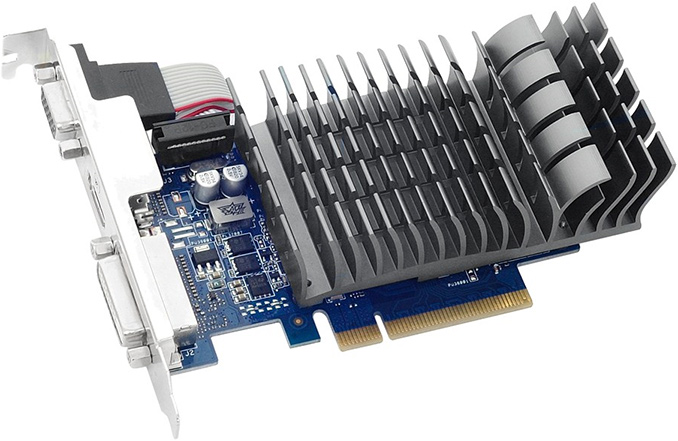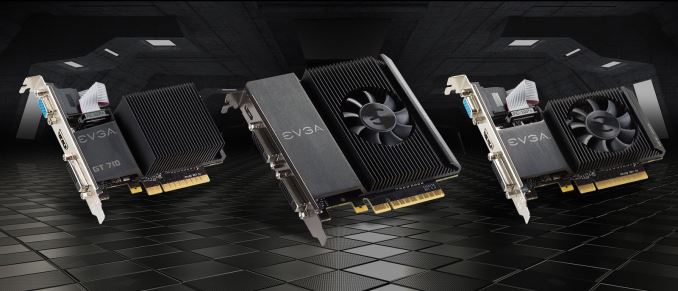NVIDIA’s Partners Roll-Out GeForce GT 710 to Fight Integrated Graphics
by Anton Shilov on January 27, 2016 1:07 PM EST
Advancements made by iGPUs by AMD and Intel in the recent years essentially destroyed the market of inexpensive discrete video cards. High-performance iGPUs can outperform low-end standalone graphics adapters these days and for a lot of users performance of integrated graphics is enough. Nonetheless, there's still a smaller market for low-end add-in boards - notably as upgrades to true entry-level PCs - and to that end NVIDIA’s partners this week released a new breed of low-end graphics cards targeting entry-level PCs.
The new NVIDIA GeForce GT 710 video cards are based on a cut-down version of the company's existing GK208 GPU, with 192 stream processors, 16 texture units and 8 ROPs. As this is a Kepler architecture product, you'll find baseline support for Direct3D feature level 11_0 but not newer features found in the Maxwell generation such as HDMI 2.0, which is likely why NVIDIA opted to launch this as a 700 series product. Peak compute performance of the GPU when clocked at 954 MHz is around 366 GFLOPS, which is below that of contemporary higher-end iGPUs by Intel or AMD. The GeForce GT 710 graphics cards are equipped with 1 or 2 GB or DDR3-1800 memory featuring 14.4 GB/s bandwidth.
| NVIDIA GPU Specification Comparison | ||||||
| GT 710 | GT 720 | GT 630 | GT 610 | |||
| CUDA Cores | 192 | 192 | 192 | 48 | ||
| Texture Units | 16 | 16 | 16 | 8 | ||
| ROPs | 8 | 8 | 16 | 4 | ||
| Core Clock | 954MHz | 797MHz | 875MHz | 710MHz | ||
| Shader Clock | N/A | N/A | N/A | 1620MHz | ||
| Memory Clock | 1.8GHz DDR3 | 1.8GHz DDR3/ 5GHz GDDR5 | 1.8GHz DDR3 | 1.8GHz DDR3 | ||
| Memory Bus Width | 64-bit | 64-bit | 64-bit | 64-bit | ||
| VRAM | 1GB or 2GB | 1GB or 2GB | 1GB or 2GB | 1GB | ||
| TDP | 19W | 19W | 50W | 29W | ||
| GPU | GK208 | GK208 | GK107 | GF119 | ||
| Launch Timeframe | January, 2016 | March, 2014 | April, 2012 | May, 2012 | ||
| Launch Price | $30 - $50 | $49 | OEM | $49 | ||
Makers of graphics cards position their NVIDIA GeForce GT 710 boards as solutions for entry-level PCs running Intel Celeron or Intel Pentium processors with mediocre iGPUs, and these are typically the comparisons you'llsee vendors make as it doesn't take much to surpass low-end iGPUs. That said, while the GeForce GT 710 can indeed be considerably faster than outdated integrated GPUs, it is unlikely that it can enable decent performance in demanding video games, and this is more likely to be pitched as a card for MOBAs and similar low-impact games.
From a sales perspective, since the GK208 GPU is not a new graphics chip - having been launched back in 2013 - it is somewhat surprising to see that virtually all partners of NVIDIA decided to release their new video cards powered by the GPU. The market for such adapters is very limited these days because 100% of entry-level PCs use iGPUs. Moreover, even in countries like China, where inexpensive hardware is sold in large quantities, more and more gamers are adopting higher-end discrete video cards, according to media reports.
Meanwhile from a technical perspective, as the GeForce GTX 710 are designed for low-end PCs, many of such video cards come in half-height/half-length form-factor. Typical for low-end cards (especially those expected to sell well in the APAC market), all of the GT 710s we've seen so far feature D-Sub analogue monitor output for compatibility with older monitors, along with the more typical DVI and/or HDMI/DP connectors. Meanwhile GT 710 is rated for a TDP of just 20 W, so many of the cards use passive cooling solutions, while the rest feature small fans.
The NVIDIA GeForce GT 710 graphics cards are available from companies like ASUS, EVGA, Galax, Gigabyte, Inno3D, Palit Multimedia, Manli, MSI, ZOTAC and some others. Prices of the GeForce GT 710-based graphics adapters vary, but typically such cards cost from $30 to $50 in the U.S.











60 Comments
View All Comments
JimmiG - Thursday, February 4, 2016 - link
Yeah I mean adding this thing to an IGP system isn't going to change anything, so what's actually the point? The IGP is already good enough for Windows desktop compisiting. Anything beyond that, neither the IGP nor this GT710 are going to be enough. You might go from 3 FPS to 6 FPS...still unplayable.I know some people can't afford high-end GPUs etc. but buying this is so pointless you're just pouring money down the drain. At lest if you buy something like a GTX 950 you can actually run games on it.
Forthrast - Saturday, February 27, 2016 - link
I just bought one of these for my wife's PC. It has a A8-3850 processor, which with its quad-core CPU and HD-6550 IGP was absolutely fine for web surfing, photo processing, MS Office and solitaire, which makes up 99.9% of what she does. However, after upgrading to Windows 10, we discovered that the IGP had been relegated to "legacy" status by AMD and the only drivers were "beta" and debilitatingly buggy. After researching the matter, I discovered that the GT 710 cards were the cheapest, lowest-power, recently new option with full, overt Windows 10 support listed on the box. I paid the $40 for a Zotac card at Microcenter, popped it in, installed the drivers: Problem solved.WorldWithoutMadness - Wednesday, January 27, 2016 - link
The only use case I cank think of is the salesman deliberately sell these to tech illiterate customers buying new system for more money.I mean for $30-50, you can get better heatsink, mobo, or processor with higher perf iGPU.
or like Anton said, for old system with low iGPU performance.
SkipPerk - Friday, February 5, 2016 - link
I buy cards like this all the time. I usually get the AMD 6450 or 5450. They are great when you need graphics with Xeon workstations or to get more monitors, not to mention other monitor cables (if you have HDMI-only monitors and all the CPU's are DVI or VGA). I routinely head over to Microcenter and buy a half dozen of these at a time. They usually cost $30.DanNeely - Wednesday, January 27, 2016 - link
The comment about all of nVidia's partners launching 710's makes me wonder, do they still require them to buy a full set of GPUs parts all the way down their stack to maintain access to the high performance/high margin parts at the top of it?az060693 - Wednesday, January 27, 2016 - link
Having HDMI 2.0 would've made it viable for an HTPC build (over intel integrated) but it doesn't have HDMI 2.0 either. Either way, you'd have to use a DP to HDMI 2.0 adapter so there's not much difference in that.tviceman - Wednesday, January 27, 2016 - link
I remember when Fermi was delayed and Charlie accused Nvidia of forcing their AIB's to buy a certain number of their first 40nm product (a very small die, very low end chip... can't remember the code name). I don't know if there was any truth to Charlie's ramblings, but who knows, we could be looking at a similar situation.... Nvidia granting priority access to Pascal if AIB's help move old inventory.extide - Wednesday, January 27, 2016 - link
Hrmm, that does sort of make sense...extide - Wednesday, January 27, 2016 - link
It is SOOO weird why they are releasing GK208 parts ... now. There is a GM208!! Why not release that..?extide - Wednesday, January 27, 2016 - link
Erm, I meant GM108 -- but still same difference!